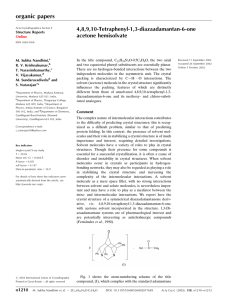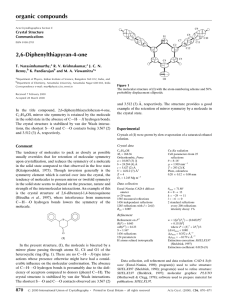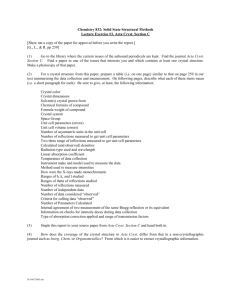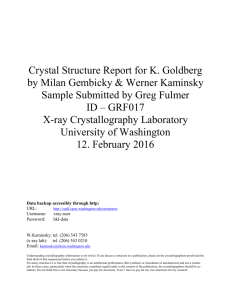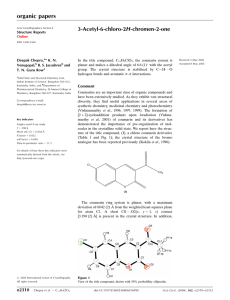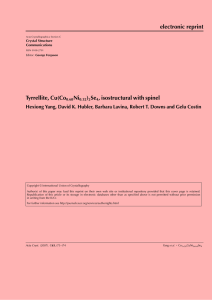organic papers 4,8,9,10-Tetraphenyl-1,3-diazaadamantan-6-one
advertisement
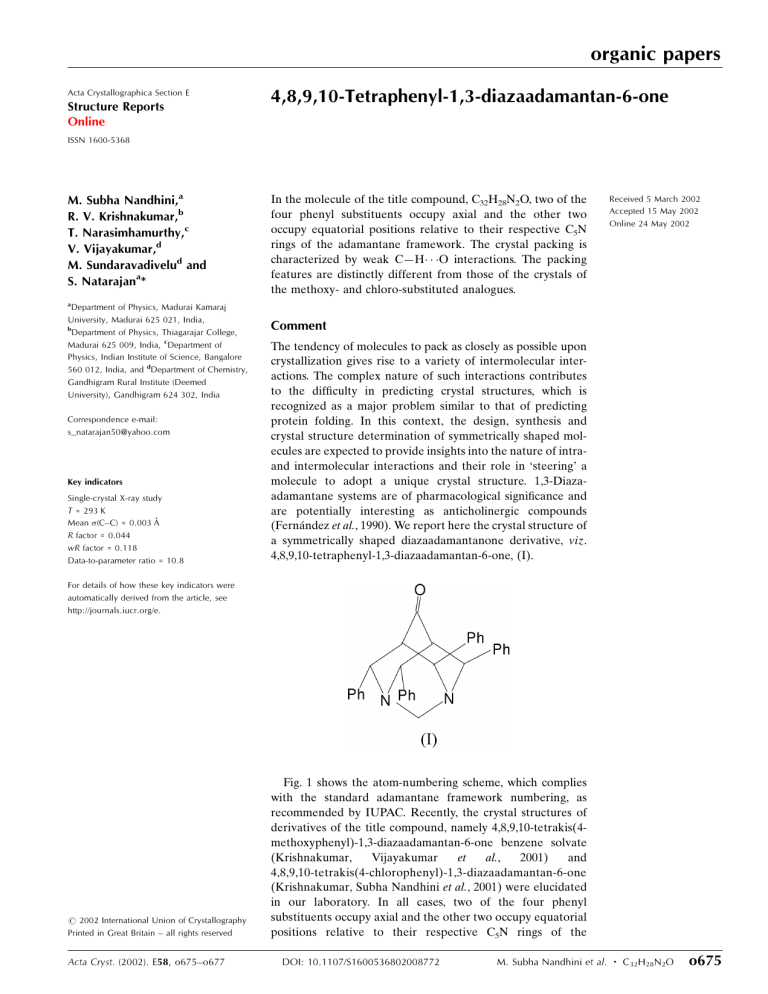
organic papers Acta Crystallographica Section E Structure Reports Online 4,8,9,10-Tetraphenyl-1,3-diazaadamantan-6-one ISSN 1600-5368 M. Subha Nandhini,a R. V. Krishnakumar,b T. Narasimhamurthy,c V. Vijayakumar,d M. Sundaravadivelud and S. Natarajana* a Department of Physics, Madurai Kamaraj University, Madurai 625 021, India, b Department of Physics, Thiagarajar College, Madurai 625 009, India, cDepartment of Physics, Indian Institute of Science, Bangalore 560 012, India, and dDepartment of Chemistry, Gandhigram Rural Institute (Deemed University), Gandhigram 624 302, India Correspondence e-mail: s_natarajan50@yahoo.com Key indicators Single-crystal X-ray study T = 293 K Ê Mean (C±C) = 0.003 A R factor = 0.044 wR factor = 0.118 Data-to-parameter ratio = 10.8 In the molecule of the title compound, C32H28N2O, two of the four phenyl substituents occupy axial and the other two occupy equatorial positions relative to their respective C5N rings of the adamantane framework. The crystal packing is characterized by weak CÐH O interactions. The packing features are distinctly different from those of the crystals of the methoxy- and chloro-substituted analogues. Received 5 March 2002 Accepted 15 May 2002 Online 24 May 2002 Comment The tendency of molecules to pack as closely as possible upon crystallization gives rise to a variety of intermolecular interactions. The complex nature of such interactions contributes to the dif®culty in predicting crystal structures, which is recognized as a major problem similar to that of predicting protein folding. In this context, the design, synthesis and crystal structure determination of symmetrically shaped molecules are expected to provide insights into the nature of intraand intermolecular interactions and their role in `steering' a molecule to adopt a unique crystal structure. 1,3-Diazaadamantane systems are of pharmacological signi®cance and are potentially interesting as anticholinergic compounds (FernaÂndez et al., 1990). We report here the crystal structure of a symmetrically shaped diazaadamantanone derivative, viz. 4,8,9,10-tetraphenyl-1,3-diazaadamantan-6-one, (I). For details of how these key indicators were automatically derived from the article, see http://journals.iucr.org/e. # 2002 International Union of Crystallography Printed in Great Britain ± all rights reserved Acta Cryst. (2002). E58, o675±o677 Fig. 1 shows the atom-numbering scheme, which complies with the standard adamantane framework numbering, as recommended by IUPAC. Recently, the crystal structures of derivatives of the title compound, namely 4,8,9,10-tetrakis(4methoxyphenyl)-1,3-diazaadamantan-6-one benzene solvate (Krishnakumar, Vijayakumar et al., 2001) and 4,8,9,10-tetrakis(4-chlorophenyl)-1,3-diazaadamantan-6-one (Krishnakumar, Subha Nandhini et al., 2001) were elucidated in our laboratory. In all cases, two of the four phenyl substituents occupy axial and the other two occupy equatorial positions relative to their respective C5N rings of the DOI: 10.1107/S1600536802008772 M. Subha Nandhini et al. C32H28N2O o675 organic papers Figure 2 Crystal packing diagram, viewed down the b axis. Experimental Figure 1 The molecular structure of (I), showing the atom-numbering scheme and 50% probability displacement ellipsoids. adamantane framework. Interestingly, in the crystal structure of the methoxy-substituted derivative, the molecule sits on a crystallographic mirror plane (along with the solvent benzene molecule) and serves as a good example of the retention of mirror symmetry by a molecule in the crystalline state. However, no such feature has been observed either in the crystal structure of (I) or in the structure of its chlorosubstituted derivative. A molecular ®t of (I) with its methoxyand chloro-substituted analogues shows a nearly perfect match except for the slight rotations of the substituent phenyl rings. Thus, it seems there is no loss of molecular symmetry, though the molecule does not lie across the mirror plane, as in the case of the methoxy-substituted analogue. Though the adamantanone cage is inherently rigid and symmetrical, the fact that the overall symmetry of the molecule is sensitive to slight rotations of the phenyl substituents at positions 4, 8, 9 and 10 might possibly play a role in displacing the molecule from a potential mirror plane in the unit cell. The distance between the centres of the phenyl substituents in the axial positions relative to the C5N rings (viz. the C41± Ê in (I), C46 and C101±C106 substituents in Fig. 1) is 3.775 (5) A Ê observed in the which is less than the value of 3.939 (6) A electron-releasing methoxy derivative and greater than the Ê observed in the electron-withdrawing value of 3.613 (7) A chloro derivative. The crystal packing is characterized by weak CÐH O interactions (Fig. 2 and Table 1). The packing features of (I) are distinctly different from those of its methoxy- and chlorosubstituted analogues, as the packing of the former does not feature any speci®c interactions, whereas the packing of the latter is determined, not only by the CÐH O, but also by the Cl Cl interactions. o676 M. Subha Nandhini et al. C32H28N2O The title compound was synthesized using the general method of preparation of 4,8,9,10-tetraaryl-1,3-diazaadamantane-6-ones as follows. (a) Preparation of 2,4,6,8-tetraphenyl-3,7-diazabicyclo[3.3.1]nonan-9-ones: 42.4 ml of benzaldehyde (0.4 mol), 15.4 g of dry ammonium acetate (0.2 mol) and 5.8 ml of acetone (0.1 mol) were mixed in 100 ml of ethanol, and the mixture was heated on a hotplate with constant shaking until the colour changed to pale orange (under the reaction conditions, ammonium acetate dissociates and liberates ammonia, which acts as the nitrogen source). The ¯ask was immediately cooled under tap water, a suf®cient amount of ether was added to the cold reaction mixture, and the precipitated 2,4,6,8-tetraphenyl3,7-diazabicyclo[3.3.1]nonan-9-ones were removed by ®ltration and washed with an alcohol±ether mixture until the yellow colour disappeared. Generally, the yield was up to 50%. (b) Preparation of 4,8,9,10-tetraphenyl-1,3-diazaadamantan-6one: 2,4,6,8-tetraphenyl-3,7-diazabicyclo[3.3.1]nonan-9-one (2.2 g, 5 mmol) was taken up in benzene (50 ml), and 40% aqueous formaldehyde (10 ml) was added. During this period, the benzene-insoluble bicyclic compound was converted to the benzene-soluble adamantanone and two clear layers separated out. The benzene layer was separated, washed thoroughly with water and evaporated to yield the crude adamantanone. The crude adamantanone was crystallized from a benzene±chloroform mixture in a 1:1 ratio and the melting points were noted (Quast & Muller, 1980; Jackman et al., 1982; Quast et al., 1982; Sivasubramanian et al., 1990; Jeyaraman et al., 1992). Colourless single crystals were obtained as transparent needles from a saturated solution of the title compound in a benzene± chloroform mixture by slow evaporation at room temperature. Crystal data C32H28N2O Mr = 456.56 Monoclinic, P21 =c Ê a = 11.7347 (14) A Ê b = 11.6976 (13) A Ê c = 17.6391 (14) A = 94.32 (1) Ê3 V = 2414.4 (5) A Z=4 Dx = 1.256 Mg mÿ3 Cu K radiation Cell parameters from 1016 re¯ections = 16±32 = 0.59 mmÿ1 T = 293 (2) K Needle, colourless 0.30 0.26 0.13 mm Acta Cryst. (2002). E58, o675±o677 organic papers Data collection 3425 independent re¯ections 2919 re¯ections with I > 2(I) Rint = 0.098 max = 58.9 h = ÿ7 ! 13 k = ÿ12 ! 11 l = ÿ19 ! 16 Siemens SMART CCD diffractometer ! scans Absorption correction: multi-scan (SADABS; Sheldrick, 1996) Tmin = 0.92, Tmax = 0.93 9728 measured re¯ections Re®nement w = 1/[ 2(Fo2) + (0.038P)2 + 0.7546P] where P = (Fo2 + 2Fc2)/3 (/)max < 0.001 Ê ÿ3 max = 0.22 e A Ê ÿ3 min = ÿ0.23 e A Extinction correction: SHELXL97 Extinction coef®cient: 0.0063 (5) Re®nement on F 2 R[F 2 > 2(F 2)] = 0.044 wR(F 2) = 0.118 S = 1.08 3425 re¯ections 317 parameters H-atom parameters constrained Table 1 Ê , ). Hydrogen-bonding geometry (A DÐH A i C86ÐH86 O1 C105ÐH105 O1ii DÐH H A D A DÐH A 0.93 0.93 2.62 2.64 3.191 (2) 3.310 (2) 120 130 Symmetry codes: (i) ÿx; y ÿ 12; 32 ÿ z; (ii) x; 12 ÿ y; z ÿ 12. All H atoms were generated geometrically and were allowed to ride on their parent atoms, with SHELXL97 (Sheldrick, 1997) defaults for bond distances and displacement parameters. Data collection: SMART (Siemens, 1994); cell re®nement: SAINT (Siemens, 1994); data reduction: SAINT; program(s) used to solve Acta Cryst. (2002). E58, o675±o677 structure: SHELXS97 (Sheldrick, 1990); program(s) used to re®ne structure: SHELXL97 (Sheldrick, 1997); molecular graphics: PLATON (Spek, 1999); software used to prepare material for publication: SHELXL97. The authors thank Professor M. A. Viswamitra for his encouragement and dedicate this paper to his memory. The authors also thank the UGC for the DRS programme. References FernaÂndez, M. J., GaÂlvez, E., Lorente, A. & CamunÄas, J. A. (1990). J. Hetrocycl. Chem. 27, 1355±1359. Jackman, L. M., Dunne, T. S., Muller, B. & Quast, H. (1982). Chem. Ber. 115, 2872±2891. Jeyaraman, R., Ravindran, T. & Sujatha, M. (1992). Indian J. Chem. B, 31, 362± 362. Krishnakumar, R. V., Subha Nandhini, M., Vijayakumar, V., Natarajan, S., Sundaravadivelu, M., Perumal, S. & Mostad, A. (2001). Acta Cryst. E57, o860±o862. Krishnakumar, R. V., Vijayakumar, V., Sundaravadivelu, M., Natarajan, S. Perumal, S. & Selvaraj, S. (2001). Acta Cryst. E57, o305±o306. Quast, H. & Muller, B. (1980). Chem. Ber. 113, 2959±2975. Quast, H., Muller, B., Peters, E. M., Peters, K. & von Schnering, H. G. (1982). Chem. Ber. 115, 3631±3652. Sheldrick, G. M. (1990). Acta Cryst. A46, 467±473. Sheldrick, G. M. (1996). SADABS. University of GoÈttingen, Germany. Sheldrick, G. M. (1997). SHELXL97. University of GoÈttingen, Germany. Siemens (1994). SMART and SAINT. Version 4.021. Siemens Analytical X-ray Instruments Inc., Madison, Wisconsin, USA. Sivasubramanian, S., Sundaravadivelu, M. & Arumugam, N. (1990). Org. Prep. Procd. Int. 22, 645±648. Spek, A. L. (1999). PLATON for Windows. University of Utrecht, The Netherlands. M. Subha Nandhini et al. C32H28N2O o677
